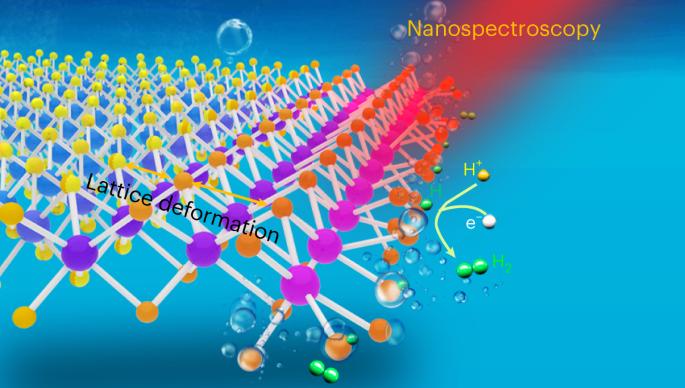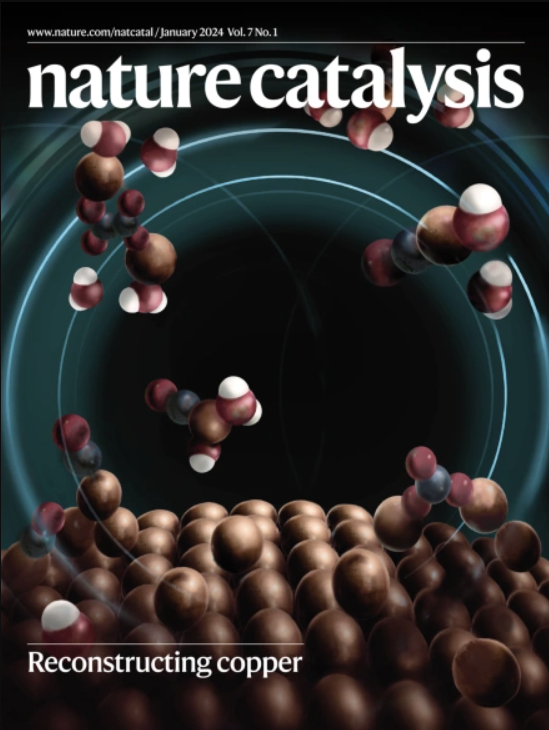电催化氢气进化反应过程中 MoS2 中单个活性位点结构演化的可视化
IF 42.8
1区 化学
Q1 CHEMISTRY, PHYSICAL
引用次数: 0
摘要
了解反应过程中单个活性位点的结构演变是表面科学和催化领域的长期目标。由于活性位点太小,表征技术无法破译其局部特性,因此现场精确表征活性位点的内在性质和演变仍然具有挑战性。在这里,我们使用电化学尖端增强拉曼光谱来监测氢进化反应过程中 MoS2 单个活性位点的几何和电子演化。在氢演化反应过程中,我们观察到从边缘到基底面的 40 nm 重建区域具有不同的晶格和电子密度。我们进一步揭示了活化过程中活性位点的逐步生成。晶格变形导致的边缘协同重构降低了活化能垒,促进了电催化反应。这些发现为我们了解电催化过程中的活性位点及其动态提供了启示。本文章由计算机程序翻译,如有差异,请以英文原文为准。


Visualizing the structural evolution of individual active sites in MoS2 during electrocatalytic hydrogen evolution reaction
Understanding the structural evolution of individual active sites during a reaction is a long-standing target in surface science and catalysis. It is still challenging to precisely characterize in situ the intrinsic nature and evolution of the active site because the active site is too small for characterization techniques to decipher the local properties. Here we used electrochemical tip-enhanced Raman spectroscopy to monitor the geometric and electronic evolution of individual active sites of MoS2 during the hydrogen evolution reaction. Reconstruction regions of 40 nm with varied lattice and electron density from the edge to the nearby basal plane were observed during the hydrogen evolution reaction. We further revealed the progressive generation of active sites during the activation process. The synergistic reconstruction around edge due to the lattice deformation reduces the activation energy barriers and promotes the electrocatalytic reaction. These discoveries offer insights into our understanding of the active site and its dynamics during electrocatalysis. Electrocatalysts are often dynamic and their surface structure changes under working conditions. Now the dynamic evolution of MoS2 edges is monitored with nanometre-resolution via electrochemical tip-enhanced Raman spectroscopy during the hydrogen evolution reaction.
求助全文
通过发布文献求助,成功后即可免费获取论文全文。
去求助
来源期刊

Nature Catalysis
Chemical Engineering-Bioengineering
CiteScore
52.10
自引率
1.10%
发文量
140
期刊介绍:
Nature Catalysis serves as a platform for researchers across chemistry and related fields, focusing on homogeneous catalysis, heterogeneous catalysis, and biocatalysts, encompassing both fundamental and applied studies. With a particular emphasis on advancing sustainable industries and processes, the journal provides comprehensive coverage of catalysis research, appealing to scientists, engineers, and researchers in academia and industry.
Maintaining the high standards of the Nature brand, Nature Catalysis boasts a dedicated team of professional editors, rigorous peer-review processes, and swift publication times, ensuring editorial independence and quality. The journal publishes work spanning heterogeneous catalysis, homogeneous catalysis, and biocatalysis, covering areas such as catalytic synthesis, mechanisms, characterization, computational studies, nanoparticle catalysis, electrocatalysis, photocatalysis, environmental catalysis, asymmetric catalysis, and various forms of organocatalysis.
 求助内容:
求助内容: 应助结果提醒方式:
应助结果提醒方式:


